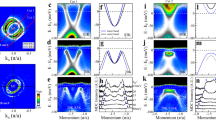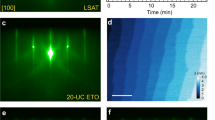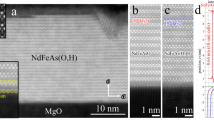Abstract
The recent discovery of possible high-temperature (Tc) superconductivity over 65 K in a monolayer FeSe film on SrTiO3 (refs 1, 2, 3, 4, 5, 6) triggered a fierce debate on how superconductivity evolves from bulk to film, because bulk FeSe crystal exhibits a Tc of no higher than 10 K (ref. 7). However, the difficulty in controlling the carrier density and the number of FeSe layers has hindered elucidation of this problem4,8. Here, we demonstrate that deposition of potassium onto FeSe films markedly expands the accessible doping range towards the heavily electron-doped region. Intriguingly, we have succeeded in converting non-superconducting films with various thicknesses into superconductors with Tc as high as 48 K. We also found a marked increase in the magnitude of the superconducting gap on decreasing the FeSe film thickness, indicating that the interface plays a crucial role in realizing the high-temperature superconductivity. The results presented provide a new strategy to enhance and optimize Tc in ultrathin films of iron-based superconductors.
This is a preview of subscription content, access via your institution
Access options
Subscribe to this journal
Receive 12 print issues and online access
$259.00 per year
only $21.58 per issue
Buy this article
- Purchase on Springer Link
- Instant access to full article PDF
Prices may be subject to local taxes which are calculated during checkout



Similar content being viewed by others
References
Wang, Q. Y. et al. Interface-induced high-temperature superconductivity in single unit-cell FeSe films on SrTiO3 . Chin. Phys. Lett. 29, 037402 (2012).
Liu, D. F. et al. Electronic origin of high-temperature superconductivity in single-layer FeSe superconductor. Nature Commun. 3, 931 (2012).
He, S. L. et al. Phase diagram and electronic indication of high-temperature superconductivity at 65 K in single-layer FeSe films. Nature Mater. 12, 605–610 (2013).
Tan, S. Y. et al. Interface-induced superconductivity and strain-dependent spin density wave in FeSe/SrTiO3 thin films. Nature Mater. 12, 634–640 (2013).
Ge, G-F. et al. Superconductivity above 100 K in single-layer FeSe films on doped SrTiO3 . Nature Mater. 14, 285–289 (2015).
Sun, Y. et al. High temperature superconducting FeSe films on SrTiO3 substrates. Sci. Rep. 4, 6040 (2014).
Hsu, F. C. et al. Superconductivity in the PbO-type structure α-FeSe. Proc. Natl Acad. Sci. USA 105, 14262–14264 (2008).
Liu, X. et al. Dichotomy of the electronic structure and superconductivity between single-layer and double-layer FeSe/SrTiO3 films. Nature Commun. 5, 5047 (2014).
Lee, P. A., Nagaosa, N. & Wen, X-G. Doping a Mott insulator: Physics of high-temperature superconductivity. Rev. Mod. Phys. 78, 17–85 (2006).
Stewart, G. R. Superconductivity in iron compounds. Rev. Mod. Phys. 83, 1589–1652 (2011).
Peng, R. et al. Tuning the band structure and superconductivity in single-layer FeSe by interface engineering. Nature Commun. 5, 5044 (2014).
Peng, R. et al. Measurement of an enhanced superconducting phase and a pronounced anisotropy of the energy gap of a strained FeSe single layer in FeSe/Nb:SrTiO3/KTaO3 heterostructures using photoemission spectroscopy. Phys. Rev. Lett. 112, 107001 (2014).
Hao, N. & Hu, J. Topological phases in the single-layer FeSe. Phys. Rev. X 4, 031053 (2014).
Maletz, J. et al. Unusual band renormalization in the simplest iron-based superconductor FeSe1−x . Phys. Rev. B 89, 220506(R) (2014).
Nakayama, K. et al. Reconstruction of band structure induced by electronic nematicity in an FeSe superconductor. Phys. Rev. Lett. 113, 237001 (2014).
Matsui, H. et al. BCS-Like Bogoliubov quasiparticles in high-Tc superconductors observed by angle-resolved photoemission spectroscopy. Phys. Rev. Lett. 90, 217002 (2003).
Norman, M. R., Randeria, M., Ding, H. & Campuzano, J. C. Phenomenology of the low-energy spectral function in high-Tc superconductors. Phys. Rev. B 57, R11093–R11096 (1998).
Haviland, D. B., Liu, Y. & Goldman, A. M. Onset of superconductivity in the two-dimensional limit. Phys. Rev. Lett. 62, 2180–2183 (1989).
Song, C. L. et al. Molecular-beam epitaxy and robust superconductivity of stoichiometric FeSe crystalline films on bilayer graphene. Phys. Rev. B 84, 020503(R) (2011).
Xiang, Y. Y., Wang, F., Wang, D., Wang, Q. H. & Lee, D. H. High-temperature superconductivity at the FeSe/SrTiO3 interface. Phys. Rev. B 86, 134508 (2012).
Lee, J. J. et al. Interfacial mode coupling as the origin of the enhancement of Tc in FeSe films on SrTiO3 . Nature 515, 245–248 (2014).
Cao, H. Y., Tan, S. Y., Xiang, H. J., Feng, D. L. & Gong, X. G. Interfacial effects on the spin density wave in FeSe/SrTiO3 thin films. Phys. Rev. B 89, 014501 (2014).
Bozovic, I. & Ahn, C. A new frontier for superconductivity. Nature Phys. 10, 892–895 (2014).
Acknowledgements
We thank Q. Xue, X. Ma, L. Wang, F. Li and W. Zhang for their advice in thin-film growth. We also thank E. Ieki, G. N. Phan, S. Kanayama and E. Noguchi for their assistance in thin-film growth and ARPES measurements. This work was supported by grants from the Japan Society for the Promotion Science (JSPS) and the Ministry of Education, Culture, Sports, Science and Technology (MEXT) of Japan.
Author information
Authors and Affiliations
Contributions
Y.M., K.N. and T.T. designed the research. Y.M., K.N., K.S. and T.S. carried out the experiment. Y.M., K.N., T.S. and T.T. wrote the manuscript.
Corresponding author
Ethics declarations
Competing interests
The authors declare no competing financial interests.
Supplementary information
Supplementary Information
Supplementary Information (PDF 741 kb)
Rights and permissions
About this article
Cite this article
Miyata, Y., Nakayama, K., Sugawara, K. et al. High-temperature superconductivity in potassium-coated multilayer FeSe thin films. Nature Mater 14, 775–779 (2015). https://doi.org/10.1038/nmat4302
Received:
Accepted:
Published:
Issue Date:
DOI: https://doi.org/10.1038/nmat4302
This article is cited by
-
Vertex dominated superconductivity in intercalated FeSe
npj Quantum Materials (2023)
-
Interplay between superconductivity and the strange-metal state in FeSe
Nature Physics (2023)
-
Atomic construction and spectroscopic characterization of FeSe-derived thin films on SrTiO3 substrates
AAPPS Bulletin (2023)
-
Angle-resolved photoemission spectroscopy
Nature Reviews Methods Primers (2022)
-
Superior carrier tuning in ultrathin superconducting materials by electric-field gating
Nature Reviews Physics (2022)



